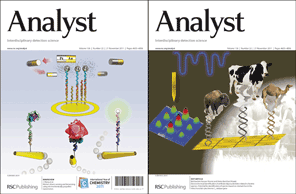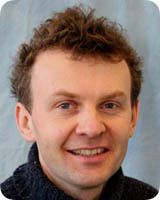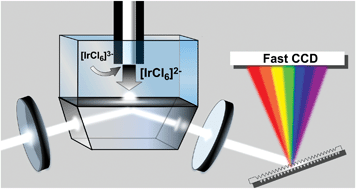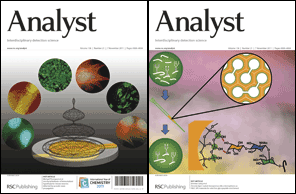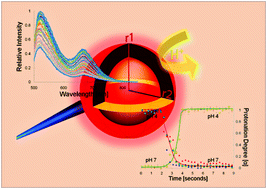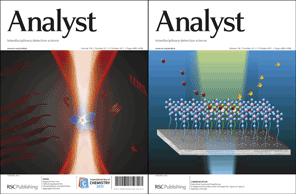Analyst and Analytical Methods are combining forces to present some of the best work on Future Electroanalytical Developments. This web theme is ongoing for coming months and amongst the papers will be those invited from speakers at Eirelec ’11, which took place in Adare, Republic of Ireland in May.
Issue 22 features a number of papers from this web theme, including both cover articles.
On the front cover, Joe Wang and colleagues review electrochemically-propelled nanomotors, which offer numerous potential applications in biomedical diagnostics, environmental monitoring, and forensic analysis.
Minireview: Motion-driven sensing and biosensing using electrochemically propelled nanomotors
S. Campuzano, D. Kagan, J. Orozco and J. Wang
DOI: 10.1039/C1AN15599G
On the inside front cover, Mohtashim Hassan Shamsi and Heinz-Bernhard Kraatz use electrochemical impedance spectroscopy (EIS) and scanning electrochemical microscopy (SECM) to distinguish between bovine species based on mitochondrial DNA fragments.
Electrochemical identification of artificial oligonucleotides related to bovine species. Potential for identification of species based on mismatches in the mitochondrial cytochrome C1 oxidase gene
Mohtashim Hassan Shamsi and Heinz-Bernhard Kraatz
DOI: 10.1039/C1AN15414A
Other papers from the web theme in Issue 22 are:
Minireview: Graphene and graphene-based nanomaterials: the promising materials for bright future of electroanalytical chemistry
Xiao-mei Chen, Geng-huang Wu, Ya-qi Jiang, Yi-ru Wang and Xi Chen
DOI: 10.1039/C1AN15661F
Electrochemical behaviour and voltammetric sensitivity at arrays of nanoscale interfaces between immiscible liquids
Mickaël Rimboud, Robert D. Hart, Thomas Becker and Damien W. M. Arrigan
DOI: 10.1039/C1AN15509A
Determination of morphine at gold nanoparticles/Nafion® carbon paste modified sensor electrode
Nada F. Atta, Ahmed Galal and Shereen M. Azab
DOI: 10.1039/C1AN15423K
A disposable sensor for point of care wound pH monitoring
Jolene Phair, Laura Newton, Cliodhna McCormac, Marco F. Cardosi, Ray Leslie and James Davis
DOI: 10.1039/C1AN15675F
Electrochemical DNA sensor by the assembly of graphene and DNA-conjugated gold nanoparticles with silver enhancement strategy
Lei Lin, Yang Liu, Longhua Tang and Jinghong Li
DOI: 10.1039/C1AN15610A
Chemically-modified graphenes for oxidation of DNA bases: analytical parameters
Madeline Shuhua Goh, Alessandra Bonanni, Adriano Ambrosi, Zdeněk Sofer and Martin Pumera
DOI: 10.1039/C1AN15631D
Asymmetric logistic peak as a suitable function for the resolution of highly asymmetric voltammograms in non-bilinear systems
Mojtaba Kooshki, José Manuel Díaz-Cruz, Hamid Abdollahi, Cristina Ariño and Miquel Esteban
DOI: 10.1039/C1AN15396J
A microfluidic device based on a screen-printed carbon electrode with electrodeposited gold nanoparticles for the detection of IgG anti-Trypanosoma cruzi antibodies
Sirley V. Pereira, Franco A. Bertolino, Martín A. Fernández-Baldo, Germán A. Messina, Eloy Salinas, María I. Sanz and Julio Raba
DOI: 10.1039/C1AN15569E


